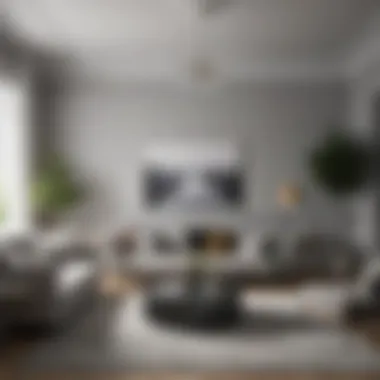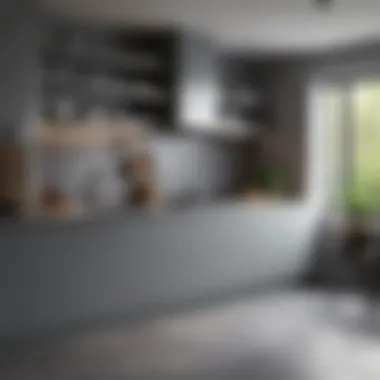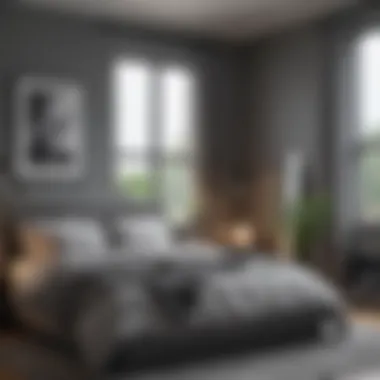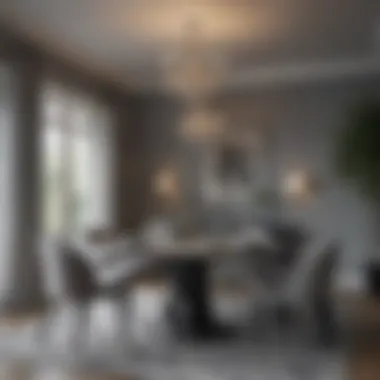Exploring Grey Interior Paint in Modern Design


Intro
Color has a profound impact on our daily lives, shaping our emotions, perceptions, and experiences. Among the myriad hues available, grey stands out as a versatile choice for interior design. Its subtleties allow for elegant expressions in homes, imbued with both modern flair and timeless appeal. This article journeys through the various dimensions of grey house paint, illuminating its psychological influences, practical uses, and compatibility with a spectrum of styles and settings.
Grey isn’t just another color; it tells stories of sophistication and grounding. Whether it’s a crisp, cool shade or a warm, muted tone, each variation brings uniqueness to a space. Homeowners and design enthusiasts alike increasingly embrace grey as they recognize its ability to enhance their surroundings in stylish ways.
Design Inspirations
Trending Styles
Design trends come and go, but grey remains a staple in the world of interiors. Its adaptability means it seamlessly fits into various styles, creating spaces that feel both inviting and polished. For example, in contemporary settings, a sleek graphite grey creates a backdrop that emphasizes clean lines and modern furnishings. Meanwhile, soft, dove greys can evoke a sense of tranquility, working wonders in serene environments such as bedrooms or reading nooks.
In the realm of traditional design, grey still finds its place, often combined with wood tones and rich textures to create a warm yet sophisticated atmosphere. Consider pairing a soft grey with deep navy or earthy tones for a classic look that never feels dated.
Color Palettes
Choosing the right shades can elevate the overall aesthetic. Here are some effective palettes that work beautifully with grey:
- Monochromatic: Utilize different shades of grey, from light to dark. This can create depth without overwhelming the senses.
- Contrasting: Pair grey with bold colors like mustard yellow or deep teal, which can inject vibrancy into the space.
- Neutrals: Combine grey with whites, beiges, or cream for a soft look that promotes peace.
- Earth tones: Incorporating greens and browns can bring an organic touch, creating a tranquil and balanced environment.
"Grey acts as a soothing intermediary between vibrant colors, offering a canvas for creativity and expression in design."
Maintenance and Upkeep
Once you've selected the ideal grey paint for your space, understanding its upkeep becomes essential. Maintaining your grey walls can enhance their longevity and appearance.
Seasonal Maintenance Checklist
- Spring: Inspect for any peeling or fading from winter elements. Clean the walls with a damp cloth to remove dust.
- Summer: Keep an eye on sun exposure. If light causes significant fading, consider window treatments.
- Fall: Touch up areas that see more wear, like hallways or children’s rooms as the school year begins.
- Winter: Ensure that your heating hasn’t caused any cracking. Address moisture or damp spots that might have appeared.
Cleaning and Organization Tips
To keep your grey walls looking sharp:
- Use a soft microfiber cloth to gently clean scuff marks.
- For more stubborn stains, a mixture of water with a mild detergent can work wonders, but be sure to spot test first.
- Stagger cleaning jobs based on the room; kitchens might need more attention than a rarely used guest room.
Grey accentuates the art of design in an exquisite manner. With the right guidance and thoughtful choices, it can transform your home into a haven of style, functionality, and warmth.
The Relevance of Grey in Interior Design
Grey has become somewhat of a darling in the realm of interior design, evolving into a pivotal shade that caters to various aesthetic tastes and functionality. Its soft, neutral presence enables a harmonious blend with a myriad of colors and textures, making it a preferred choice for many homeowners. When one considers the beauty of grey, it’s easy to dismiss it as just another paint color, but its implications are profound.
One of the primary benefits of grey is its versatility. Whether it's a minimalist space or a lavishly adorned room, grey can serve as a backdrop that accentuates other design elements rather than competing with them. The hue has this unique ability to adapt itself, offering depth and sophistication. Furthermore, unlike some flashy colors, grey emanates a sense of calmness, allowing spaces to feel more open and welcoming.
Beyond its adaptability, grey also possesses the strength to evoke emotions and influence moods. This color often sits at the intersection of tradition and modernity, often seamlessly fitting into both styles. It’s this balance that contributes to grey's enduring relevance in modern interiors.
Historical Context of Grey in Design
Historically speaking, grey is not just a modern phenomenon. Ancient Romans used shades of grey in their grand architectural feats, and eventually, it found its way into Renaissance art as artists embraced the calming, timeless quality it brought to their bodies of work. Fast forward to the 20th century, the rise of minimalism further propelled grey into everyday design. The Mid-Century Modern movement celebrated simplicity, and grey emerged as an understated hero in many iconic designs.
As decades rolled on, the industrial revolution introduced urban spaces dominated by concrete structures, inherently grey in nature. This left a lasting imprint on the population’s perception of the color. In contemporary times, designers often pull from this rich history, reinventing shades of grey that echo both past and present inspirations, thus embedding grey deeply into our modern consciousness.
Cultural Associations with Grey
Grey doesn’t just linger in the background; its cultural associations are as varied as they are rich. In many parts of the world, grey symbolizes stability and professionalism. It’s often seen in office spaces where one wishes to convey seriousness without overwhelming energy. This practical aspect makes grey a favorite for business environments advocating productivity and focus.
However, cultural interpretations can swing in different directions as well. In some Asian cultures, grey may be linked to humility and a sense of tranquility. In this context, using grey in design can evoke comfort for visitors and residents alike. Generally, it’s this dual nature of grey - both a grounding color and a peaceful presence - that makes it universally appealing across various cultures, resonating with different groups of people in distinct ways.
"Grey operates on a spectrum that is both versatile and profound, providing a foundation for personal expression in living spaces."
By understanding the nuances surrounding grey, homeowners and design enthusiasts can better appreciate its place in interior design. This hue, rich in history and layered in meaning, offers a canvas truly fit for creative exploration.
Psychological Impacts of Grey
Grey, while often seen as a neutral backdrop, serves a more nuanced role in interior design. The colors we choose to surround ourselves with can significantly affect our emotions, moods, and perceptions of space. Understanding the psychological impacts of grey is crucial for homeowners and interior design enthusiasts aiming to create spaces that resonate personally and foster well-being.
Calmness and Serenity
When one thinks about grey, a sense of calm often washes over. This subtle color can evoke feelings of tranquility, making it an excellent choice for spaces intended for relaxation. Psychologically, grey is often associated with neutrality and balance. It's neither overly stimulating nor depressingly dull; it falls comfortably in between. This makes it a perfect canvas for creating peaceful environments.
For instance, consider a bedroom painted in a soft, warm grey. This shade can help lower stress levels, allowing inhabitants to unwind after a long day. By adding textiles like soft blankets or cushions in varying shades of grey or complementary colors, a serene atmosphere can be achieved without overwhelming the senses.


- Some calming grey shades include:
- Pigeon Grey: a gentle, muted tone that invokes a feeling of softness.
- Mist Grey: which provides a slightly cooler and airy ambiance.
Importantly, individuals need to be mindful when selecting grey hues. Too cool a tone in a poorly lit room may lead to feelings of coldness, where the space can feel unforgiving rather than serene. Therefore, pairing grey with warmer elements, like wooden accents or plush rugs, can create comfort and warmth without losing that tranquil effect.
"Grey can provide a soothing backdrop, enabling other elements within your space to shine, while contributing to a feeling of calm and reflection."
The Effect on Space Perception
Grey has an interesting relationship with spatial perception. Depending on the tone, it can make a space appear larger or more intimate. Lighter greys reflect light, creating an illusion of a more expansive area. This is particularly useful in smaller rooms where one might want to maximize the feeling of openness.
On the flip side, darker greys can evoke a coziness that invites intimacy. They can draw the eye inward, making spaces feel more inviting and snug. It's essential to think about room size and natural light before going full throttle with dark grey paints.
Common grey shades that can be utilized for various spatial effects include:
- Charcoal Grey: often used in larger, well-lit areas for a dramatic effect.
- Cloud Grey: works well in smaller spaces to enhance light and openness.
Choosing the right grey can help signify the intended function of a space, whether it's for social gatherings or quiet reflections. Just as speaking in hushed tones creates a peaceful atmosphere, applying the right shade of grey can enhance one’s environment in meaningful ways. As such, homeowners and designers alike can make use of grey to guide emotional responses and perceptual experiences in their interior spaces.
Understanding Shade Variations in Grey
When it comes to interior design, the color grey is not just a single shade; it's a spectrum that plays a pivotal role in setting the mood and tone of a space. Understanding these shade variations can drastically change how a room feels, how light interacts with the surfaces, and even how people respond emotionally. It’s imperative for homeowners and design enthusiasts to grasp the nuances of grey, not only to enhance aesthetic appeal but also to promote practicality and harmony in their interiors.
Grey can be warm or cool, light or dark. This variation is crucial and can either complement or contrast with existing decor elements. A thoughtful selection of different tones can help define spaces more clearly and add layers of depth that might otherwise go unnoticed. For instance, a warmer grey can evoke coziness in a living room while a cooler hue can create a crisp and modern feel in a home office.
Moreover, different shades can be combined creatively for accent walls, furniture finishes, or decorative features, emphasizing a cohesive yet dynamic design approach. With grey as a backdrop, adding textures and materials becomes even more significant, allowing for a rich aesthetic experience.
Warm vs. Cool Greys
Warm greys typically have brown or yellow undertones. They tend to produce an inviting atmosphere, making spaces feel more like home. Imagine settling into a reading nook drenched in a soft, warm grey. It envelops you in a sense of tranquility. This type of grey is excellent choice for bedrooms and living rooms, where comfort is key.
On the flip side, cool greys lean towards blue or green undertones. They create a livelier, modern appearance that can make spaces feel more expansive. Think of a sleek kitchen where fresh ideas brew while the cool grey enhances the stainless-steel appliances. This shade helps focus attention on bold colors, drawing out the vibrancy of other design elements.
Key distinctions and considerations:
- Warm greys can soften harsher colors in a palette, making them an excellent choice for pairing with shades like mustard yellow or rust.
- Cool greys are ideal for contemporary designs, often used to highlight architectural features or modern art.
Popular Shade Choices
When delving into specific shade choices, several colors stand out among interior designers and homeowners alike. For a broad palette to consider:
- Reverie Grey: A light, warm grey that evokes a soft and soothing ambiance, perfect for bedrooms or serene spaces.
- Charcoal Grey: Dark and sophisticated — it can anchor a design, especially in home offices or dining areas.
- Steel Grey: A medium, cool grey that's versatile and works beautifully in modern spaces, notably in kitchens.
- Greige: A blend of grey and beige. This shade gives warmth but retains the sophistication of grey, ideal for open-plan areas.
In selecting the right shade, consider the existing elements of a room: fixtures, flooring, and furnishings. The synergy between them determines the emotional and aesthetic success of the chosen grey.
"When choosing grey, think about how it interacts with light and the other colors in your palette. A grey can change drastically depending on what surrounds it."
As designers seek to marry function and beauty, understanding these variations in grey shade allows for the creation of spaces that are not only visually appealing but also provide the comfort and functionality that modern living demands.
Practical Applications of Grey Paint
In the realm of interior design, grey paint stands as a versatile canvas, unfolding possibilities that resonate with both the modern ethos and individual aesthetics. Its practicality in various spaces highlights its adaptability, modern vibe, and ability to harmonize with diverse styles. Many homeowners may overlook the true potential of grey, attributing it solely as a neutral backdrop. However, proper application of grey paint can significantly enhance functionality and atmosphere, making a space feel inviting yet sophisticated.
Living Rooms
The living room, often seen as the heart of a home, serves as a perfect backdrop for grey. Opting for a soft greige can create a cozy warmth, while a deeper slate grey might provide a dramatic flair. Lighting can twist the color perceptions here; a sunny room may transform the shades to feel lighter and airier. Consider layering textures in this space—small pops of color through furniture or art can elevate the grey. Moreover, using grey as the primary color can boost the sense of a spacious area when paired with ample natural light. When decor is sprinkled with warm metallic accents or lush textiles, it can create a stunning interplay that mesmerizes and enchants.
Bedrooms
In bedrooms, the choice of grey can foster tranquility. Light hues like cloud white with a hint of grey can evoke calm, making it ideal for restful evenings. Darker tones, such as charcoal, lend themselves well to a moody sophistication, encouraging a cocooning effect.
- Consider incorporating bedding in soft whites or muted colors to contrast against the grey walls. This creates a harmonious balance that encourages serenity.
- Accessorize with soothing textures like wool throws or linen cushions, which can contribute to the feel of comfort.
When introducing grey in the bedroom, attention to lighting is crucial—different bulbs can cast varying hues that transform the overall feel of the space at different times of day.
Kitchens and Dining Areas
Grey in kitchens or dining areas can appear chic and practical, especially when paired with modern appliances or warm wood tones. Lighter greys can open spaces up, providing a fresh, clean look, while deeper tones can exude elegance and depth. Some practical pointers include:
- Combination with white or soft pastels can add brightness and keep the area from feeling too heavy.
- Opt for grey cabinetry with brushed nickel hardware; this can bring a touch of sophistication without overwhelming.
Dining areas often benefit from a muted grey tone, creating a serene setting, allowing dishes and decor to take center stage. Grey paint can subtly frame the dining experience, fostering connections amid meals without overpowering the senses.


Home Offices
In home offices, grey can act as an empowering backdrop, promoting focus and productivity. Pale grey helps keep distractions at bay and creates an uncluttered feeling, while darker shades can frame your workspace, echoing professionalism.
To optimize functionality:
- Choose desks and accessories that contrast well with grey, such as natural wood or vibrant hues, which can invigorate the work environment.
- Think about the integration of plants—those greens pop beautifully against grey, bringing life into a structured workspace.
"A well-thought-out color scheme can turn a mundane office into an inspiring workspace."
Moreover, the right balance of lighting is fundamental to keep the space inviting and encourage creativity. Task lighting, such as desk lamps, combined with ambient options can complete the grey palette, ensuring that it serves both aesthetic and functional purposes.
Using grey paint in practical applications across various spaces not only enhances the style but also reflects the home's character. Each color decision and corresponding decor element play a significant role in achieving an inviting atmosphere.
Pairing Grey with Other Colors
When it comes to interior painting, pairing grey with other colors opens up a world of aesthetic possibilities. Grey is often perceived as a neutral backdrop, but its range of tones can create unique palettes that enhance a room's character. This section will dive into the specifics of how to effectively mix grey with different colors, along with the benefits that such combinations bring to your space.
Complementary Color Schemes
Complementary color schemes involve adding colors that sit opposite grey in the color wheel. While grey is often viewed as a neutral tone, it holds subtle hues that can play beautifully with vibrant colors such as burnt orange, soft pink, or even a deep navy. For example, imagine a light grey wall adorned with accents of burnt orange in throw pillows or artwork; the warmth of the orange juxtaposes elegantly against the coolness of the grey, creating a striking visual impact in the living space.
- Tips for selecting complementary colors:
- Consider the undertones: Warmer greys pair well with warmer shades while cooler greys complement cooler ones.
- Highlight with patterns: Use patterned textiles that incorporate both grey and your chosen accent color to pull the room together.
- Room purpose: The function of the room can influence your choice. For instance, in a cozy reading nook, soft warm tones blend well with grey, fostering relaxation.
Practically speaking, you want to ensure your accent colors contribute to the overall vibe you’re aiming for:
- Use burnt orange for a friendlier, inviting atmosphere.
- Incorporate deep blues or navy for sophistication.
"The right color combination can transform an ordinary grey wall into a breathtaking backdrop for your entire design."
Accent Colors to Enhance Grey
Unlike complementary colors, accent colors serve to enhance rather than contrast. Colors like mustard yellow, burgundy, or forest green can be excellent choices to enrich grey hues. An accent color should ideally create focal points within the room without overwhelming the serenity that grey tends to evoke.
For instance, a master bedroom featuring a grey headboard can be beautifully complemented by mustard yellow pillows. The yellow introduces warmth and vibrancy, creating a cozy and inviting feel. On the other hand, a room filled with grey might risk becoming too sterile without the right accent touches.
Here are some key points to keep in mind:
- Balance is crucial: Ensure the ratio of grey to accent colors feels natural. Too much grey might drain energy from the space, while too much color might overshadow its neutrality.
- Textures matter: Pair flat grey paint with textured textiles in your accent colors. This variation helps avoid a monotonous look.
- Personalize the palette: Don't shy away from experimenting with colors that resonate personally. It could mean blending natural earthy tones or even strong jewel tones, depending on your style preferences.
In essence, when pairing colours with grey, the goal is to craft a harmonious environment that resonates with one’s taste while also serving its intended purpose. This is where thoughtful consideration of shades, textures, and room functionality plays a pivotal role in achieving a cohesive and aesthetically pleasing home design.
Textures and Materials that Work with Grey
When it comes to incorporating grey in interior design, the textures and materials used alongside this versatile shade play a crucial role. With grey often serving as a neutral backdrop, the choice of textures can either enliven the space or contribute to a more subdued, serene atmosphere. An understanding of how materials interact with grey opens a world of design possibilities, allowing homeowners and enthusiasts to create environments that resonate with intention.
Wood and Grey
Using wood in tandem with grey paint is nothing short of a match made in heaven. The warmth and natural feel of wooden elements can soften the coolness of grey, establishing an inviting ambiance in homes.
- Types of Wood: Light woods like birch or ash complement soft greys, lending an airy feel, while darker woods such as walnut or mahogany create a stunning contrast against charcoal or slate greys.
- Applications: This pairing works beautifully in spaces like living rooms, where a grey-painted wall acts as a backdrop for wooden furniture or accent pieces, allowing the textures to play off one another. Dining tables made of reclaimed wood can also provide a rustic charm, harmonizing with various shades of grey.
- Considerations: Pay attention to grain patterns and finishes on the wood. A matte finish can feel more understated alongside a flat grey, while a glossy finish could contribute an unexpected vibrancy.
Metallic Accents
Adding metallic accents to a grey-dominant palette can take a design from ordinary to striking. Metallics like gold, copper, and silver can inject life and elegance into grey interiors.
- Bespoke Fixtures: Think about how light fixtures in brass or polished nickel contrast and pop against a grey background. These accents reflect light, creating layers of interest and ensuring the space isn’t too flat.
- Furniture Details: Items like coffee tables with metallic legs or side tables adorned with metallic features can also enhance the visual appeal.
- Considerations: Balance is key. A little sparkle goes a long way, so consider using metallics as highlights rather than the main focus. Sticking to one metallic finish can maintain a cohesive look.
Fabric Choices
Fabric is another essential element when working with grey. From curtains and cushions to upholstered furniture, the right fabric can elevate any grey space significantly.
- Color Coordination: Soft fabrics in complementary colors, such as blush pink or deep blue, can create warmth and contrast beautifully with grey. Likewise, patterns that incorporate shades of grey with other hues—like muted gold or beige—can tie the room together.
- Texture Matters: Playing with texture can add depth to the design. Combine smooth throw pillows with coarse knitted blankets or sleek curtains with velvety upholstery. This interplay keeps the eye moving and makes the space inviting.
- Durability and Practicality: Consider practicalities as well. Some fabrics are more susceptible to fading when exposed to sunlight, while others may resist stains better—important factors when choosing for high-traffic areas.
Maintaining a Cohesive Design Narrative
Maintaining a cohesive design narrative within a space is essential for creating an environment that feels harmonious and thoughtfully curated. This narrative is not merely about color selection but involves understanding how various design elements interact with each other. When it comes to grey interior paint, establishing this narrative can elevate the overall aesthetic and functionality of your home.
A successful design narrative intertwines various aspects like color, texture, layout, and decor choices, allowing them to resonate with one another. This coherence helps to avoid a disjointed look, ensuring that the space feels interconnected rather than jarring. Grey, being a neutral color, serves as an ideal backdrop that complements and enhances other design elements, contributing to this harmonious atmosphere.


Incorporating Art and Decor
Art and decor are pivotal in reinforcing the cohesive narrative of your interior design. When you use grey paint, consider how artwork and decor pieces can either contrast or enhance the color. For example, a brilliant splash of red art might stand out beautifully against a soft dove grey wall. Conversely, muted greens or blues can create a serene flow that enhances the calming properties of grey.
In choosing decor, it’s wise to think about the common themes and motifs that emerge across your pieces. If, for instance, a modern minimalist style is at play, select clean-lined artwork that features your main color palette. Textiles like throw pillows and rugs can help blend hues and introduce textures, further reinforcing the narrative.
Tips for Incorporating Art and Decor:
- Focus on Scale: Large artworks on grey walls can create bold statements.
- Frame Coordination: Use frames that share colors or materials with your furniture.
- Layering: Don’t hesitate to layer different materials; a grey canvas can be the perfect background for unusual textures like wood or metal.
"The way you choose art pieces can make or break the cohesive feel of a room.
Consistency Across Spaces
Consistency across various spaces within a home is another crucial aspect of maintaining a cohesive design narrative. While every room serves a unique function, ensuring that they share common elements can create a seamless transition from one area to another. This is particularly significant when using grey, as its many shades allow for versatility while remaining linked.
For instance, if you employ a warm grey in your living room, consider using a similar warm tone in adjacent areas like the hallway or kitchen. This creates visual continuity, guiding the eye through the spaces without interruption. Furthermore, if you opt for specific fabrics or patterns in one room, repeating or echoing them in other locations can solidify your overarching theme.
Key Considerations for Ensuring Consistency:
- Shared Color Palette: Stick to a defined palette where grey complements other dominant colors throughout.
- Repeating Patterns: Incorporate similar patterns or textures to tie rooms together.
- Furniture Styles: Use consistent furniture styles or finishes that can bridge the different spaces.
By practicing these strategies and thoughtfully utilizing grey interior paint, your home's design narrative will emerge as a cohesive and inviting experience.
Common Mistakes to Avoid
When it comes to selecting and applying grey paint in interiors, a few blunders can easily derail your vision. A keen eye for detail and a solid understanding of how grey interacts with light and space are critical. Avoiding these common pitfalls will bring your design to life and help you create the environment you desire.
Underestimating Lighting Effects
One of the most significant oversights is failing to consider how lighting affects grey paint. Natural light can transform a shade of grey, revealing undertones that might not be visible under artificial light.
Think of it this way: a cool grey in the morning sun may appear almost blueish, while in the soft glow of the evening, it might adopt a warmer hue, leaning towards taupe. This shifting quality can either make or break a room's aesthetic. Therefore, when choosing your paint, ensure you test samples in various lighting conditions.
Consider the following factors:
- Type of light: Different bulbs emit different hues. A warm incandescent bulb might cast an amber glow, while LED lighting can appear stark and bright.
- Room orientation: North-facing rooms generally receive cooler, softer light, which may wash out your chosen grey. South-facing rooms bask in warmth, enriching the overall color.
- Time of day: As the sun moves, the light will change, so make sure to evaluate your paint at different times.
"A color seen in daylight and then in evening can feel like two entirely different colors. See it in various lights!"
Ultimately, the goal is to ensure that your grey hues resonate harmoniously with the lighting of the space.
Disregarding Overall Design Intent
Another blunder is not aligning paint choices with the overall design philosophy of your space. Grey, while versatile, can easily clash with other elements if it’s not in sync with the broader design narrative.
Before committing to a shade, reflect on these considerations:
- Theme consistency: Is your design contemporary, rustic, or eclectic? The shade of grey you choose should complement the overall theme.
- Functional considerations: Living spaces and bedrooms often require different atmospheres. A lively grey might work well in a social area but could be too stimulating for a bedroom where relaxation is key.
- Furnishings and fixtures: From your sofa to your drapes, ensure that your chosen colour has good synergy with existing or planned decor.
Moreover, the textures and materials you incorporate—wood, metal, fabrics—must also relate back to your grey choice. After all, a considered design speaks volumes about taste and intentionality.
Embracing these principles can prevent grey from feeling out of place, ensuring the space achieves the vision you had in mind.
Finale: The Role of Grey in Modern Interiors
Grey has carved out its place in contemporary interior design not just as a color, but as a narrator of taste and style. Its ability to adapt offers countless benefits for homeowners, interior design enthusiasts, and even party hosts looking to create an inviting atmosphere. The significance of incorporating grey in your home is underscored by its versatility, calming presence, and compatibility with numerous design elements.
Unlike the loud and brassy colors that often shout for attention, grey speaks softly, weaving in and out of spaces, enhancing rather than overpowering. This subtlety allows the color to serve as a canvas where other elements of design can shine. Whether it's through furniture, art, or décor, grey allows you to play with textures and layers, making it a strategic choice for anyone aiming to achieve a well-rounded interior.
Final Thoughts on Grey's Versatility
Grey’s nature as a neutral color is like a chameleon that adapts to its surroundings. It has the unique power to create varying moods, depending on how it's combined with other colors or how light interacts with it. For instance, a light, soft grey can instill a sense of peace in a bedroom or nursery, while a darker shade can evoke sophistication in a dining area or home office. Homeowners should consider how different shades of grey can redefine a space's aesthetic appeal.
The key takeaway here is that grey can distance itself from being just a fallback option.
- Use as a Base: It can act as the base that complements the brighter aspects of a room.
- Balance with Boldness: Grey can also stand as a bold statement when paired with sharper colors, creating stimulating contrast.
Encouraging Experimentation with Shades
As with any artistic endeavor, experimentation is the gateway to unlocking creativity, and grey is no exception. Homeowners are encouraged to play with different shades and formulations, exploring how warmth or coolness can alter the feel of their rooms. Consider the following when experimenting:
- Samples on Walls: Apply small patches of various shades to see how they transform under natural and artificial light.
- Incorporate Textures: Participation of fabrics and materials can enrich the look when shades are combined. Imagine sleek grey paint paired with velvety cushions or wooden accents for a cozy yet modern feel.
"In design, it's essential to remember that the smallest decisions often carry the most weight. Allow grey to remind you of the beauty stemming from subtleties."
While venturing into grey territory, homeowners should also keep their personal preferences in mind. One's home should reflect individual tastes and feelings; so, don't hesitate to break boundaries. Grey is not just a color; it’s a lens to view the pluralities of style, emotion, and function in one’s living space.
By now, hopefully, you see grey not merely as a color but as a wellspring of possibilities. The versatility it brings invites an array of expressions that can cater to anyone's style, making it a prominent choice in modern interiors.







